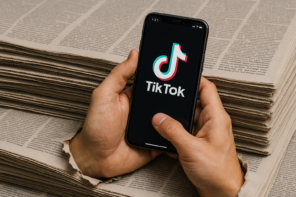
Monday April 7, 2025
Disinformation, AI and the Fragmented Future of PR
The research, based on interviews with 44 senior communications leaders across sectors, offers a nuanced view of how Chief Communications Officers (CCOs) and media relations professionals are adapting to an increasingly volatile media environment—not just in the U.S., but in ways that resonate across Europe, Asia, the Middle East, and beyond.
Shrinking Newsrooms and the Global Decline of Traditional Journalism
The contraction of the journalism industry is not confined to North America. Across the globe, local and regional news outlets are being shuttered at an alarming rate. In the UK, the Press Gazette has reported the closure of nearly 300 local publications over the past two decades. In Africa and parts of Asia, news organisations face severe funding shortages and political pressures. In the Gulf and South Asia, state-linked or politically influenced media dominate, further distorting the information landscape.
IPR’s report underscores that fewer journalists are covering broader beats with less depth, time, and industry knowledge—forcing communicators to step in as both educators and content providers.
“We’re often dealing with someone covering a catch-all beat… It puts the onus on us to educate reporters,” said one insurance comms director.
Strategic Adaptation: From Storytelling to Sponsored Content
Earned media still holds prestige, but it’s becoming harder to secure. As a result, organisations are increasing investment in:
- Paid media partnerships
- Sponsored content
- Owned media ecosystems
- Influencer collaborations
Yet, these shifts raise concerns. One respondent noted that sponsored content is often “uninteresting for readers,” while others highlighted the credibility gap with influencers lacking subject-matter expertise.
For global brands, this shift has significant implications: in markets where press freedom is limited, sponsored content may be the only viable route—but it must be carefully crafted to maintain trust and authenticity.
The Rising Threat of Misinformation and Disinformation
The report’s timing aligns with IPR’s Disinformation Awareness Month—an initiative urgently needed.
Across markets, the explosion of clickbait, AI-generated content, and polarised media bubbles is eroding trust and challenging truth. Executives interviewed for the study shared that their teams are:
- Developing internal misinformation playbooks
- Using “pre-bunking” techniques to inoculate audiences
- Conducting real-time social listening
- Building direct relationships with platforms to request takedowns of fake accounts
“Transparency and credibility are the foundations of our comms strategy,” said a transportation CCO. “We fact-check rigorously before publishing anything.”
For multinational communicators, the challenge is compounded. A false narrative can begin in one country and ripple across global markets within hours. Cross-border crisis simulations and scenario planning are now essential tools in the global communicator’s arsenal.
AI: Opportunity or Pandora’s Box?
AI’s role in media relations is still nascent—but growing. Some professionals are experimenting with AI for:
- Content ideation
- Drafting pitches
- Media monitoring
- Assessing message resonance across markets
But concerns remain: the risk of “deepfake” journalism, automated disinformation, and the devaluation of trusted media sources.
“AI could be as transformative to PR as the spreadsheet was to accounting,” said one comms manager. “But the rules of play are not yet clear.”
This reflects a global truth: AI is developing faster than regulatory or ethical frameworks. PR professionals must lead—not follow—in establishing ethical standards for AI use in communication.
The Education Gap: Boards and the C-Suite
One of the study’s more candid findings is the mixed level of awareness and adaptation among leadership. Globally, CCOs report that many CEOs and Boards are still focused on traditional media metrics and prestige press, often failing to grasp the urgency of digital transformation and media fragmentation.
This presents both a challenge and an opportunity. Strategic comms leaders are bridging the gap by:
- Hosting quarterly media briefings for boards
- Using dashboards to illustrate real-time sentiment and risk
- Bringing in external experts to contextualise new threats like AI or coordinated disinformation
This work is vital for global organisations operating in varied political and media environments, where a nuanced understanding of each landscape is key to avoiding reputational risk.
What the Future Holds: From Polarisation to Possibility
Looking ahead to 2029, the report predicts:
- Continued decline of traditional journalism
- Increased fragmentation of media audiences
- Rise of citizen journalism and digital-first outlets
- AI-driven content proliferation
- Deepening polarisation and loss of trust in mainstream sources
“There will be more disinformation, more clickbait, and more division,” predicted one global CCO. “But there will also be opportunities—for those who invest in trust, agility, and relevance.”
Curzon PR’s View: What This Means for Global Communicators
At Curzon PR, we see this study as a call to action. Disinformation is no longer a fringe issue—it is a strategic threat. AI is not just a tool—it’s a new layer in the communications ecosystem. And PR is no longer just about media—it’s about navigating competing truths in a divided digital world.
As Disinformation Awareness Month unfolds, we encourage our peers across the PR and comms industry to:
- Audit your organisation’s vulnerability to disinformation
- Establish cross-functional crisis protocols that include comms, legal, and tech
- Prioritise education for senior leaders about media and AI trends
- Invest in strong media relationships, not just media placements
Because in today’s world, being heard is not enough. Being trusted is everything.
📚 Explore the full IPR report here
🛡️ Join the global campaign for Disinformation Awareness Month
Curzon PR is a London-based PR firm working with clients globally. If you have any questions, please feel free to contact our Business Development Team bd@curzonpr.com







Follow us